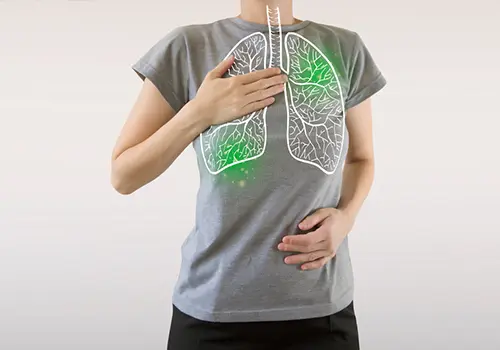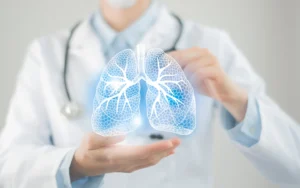What is Lung Cancer?
In general, it is common for the cells of living organisms to undergo controlled division and growth. However, lung cancer is a disease characterized by uncontrolled division and growth of lung cells, leading to the formation of a tumor that can cause significant damage to the lungs.
If left untreated or delayed in treatment, this tumor can metastasize to other parts of the body such as lymph nodes, adrenal glands, liver, bones, and the brain. Lung cancer is a prevalent disease that affects both men and women each year and is the second leading cause of cancer-related deaths among women, following breast cancer.
What Types of Lung Cancer Exist?
Lung cancer can be broadly categorized based on the microscopic appearance of the cells as follows:
- Small Cell Lung Cancer (SCLC)
- Non-Small Cell Lung Cancer (NSCLC)
Approximately 80 to 85 percent of lung cancers are classified as non-small cell lung cancer. This type typically remains confined to the lung and does not extend beyond the chest cavity. Surgical intervention and tumor removal are often employed in the treatment of this malignancy.
What Are the Symptoms of Lung Cancer?
Lung cancer typically presents no symptoms in its early stages and only manifests symptoms to some extent as it advances. Individuals with lung cancer often experience one or more of the following symptoms:
- Persistent cough with mucus or blood-tinged sputum
- Chest pain or chest tightness
- Breathing difficulties and shortness of breath
- Chest discomfort
- Fever
- Difficulty swallowing food
- Hoarseness
- Loss of appetite and unexplained weight loss
- Heart palpitations (in cases where the tumor is close to the heart)
When lung cancer metastasizes beyond the lungs, it produces additional symptoms. For instance, if it spreads to the bones, bone pain is added to the symptoms. However, these symptoms are not exclusive to lung cancer and other medical conditions may produce similar symptoms.
Therefore, it is advisable to consult with an internal medicine specialist or pulmonologist upon experiencing these symptoms. In specific types of small cell lung cancer, the body releases substances that disrupt the regulation of certain substances like calcium and sodium in the bloodstream. Any imbalance in these levels can indicate a likelihood of this type of lung cancer.

Lung Cancer Diagnosis
When presented with the above-mentioned symptoms, a medical specialist diagnoses the disease using medical imaging techniques such as X-rays or CT scans. Additionally, the physician may perform a biopsy to extract cells from the suspicious mass.
This can be done through bronchoscopy or by inserting a needle through the skin into the lung tumor. In cases where these methods prove ineffective, surgery may be necessary for a definitive diagnosis.
Pleural Effusion in Lung Cancer
Lung cancer is known as a primary cause of pleural effusion, which is often referred to as lung fluid or pleural edema. In such cases, the individual’s respiratory system is challenged, resulting in breathing difficulties.
Normally, air fills the lungs during inhalation, but the presence of fluid in the lungs causes it to occupy the space of the air, thus obstructing the transfer of oxygen into the bloodstream.
Lung Cancer Treatment
The choice of treatment options depends on the stage of the disease and its spread throughout the body. In the management of non-small cell lung cancer confined to the chest cavity, the most important approach is surgical removal of the cancerous mass. The type of surgical intervention depends on the size of the tumor and the presence of other lung diseases.
In some cases, partial lung removal may suffice, while in others, complete lung removal may be necessary. However, surgery may not be the appropriate choice for patients with multiple comorbidities or poor lung function, and a multidisciplinary team consisting of pulmonologists, medical oncologists, and radiation oncologists thoroughly evaluate such cases.
Chemotherapy plays a crucial role in the management of lung cancer that has extended beyond the chest cavity and may be prescribed before or after surgery. This treatment method involves the use of drugs to target rapidly dividing cells, usually administered intravenously or through oral routes.
However, chemotherapy is not without its challenges, as it affects normal cells as well, requiring a delicate balance between therapeutic efficacy and reducing side effects. The type and dosage of specific drugs determine the nature of side effects. Radiation therapy may be used in conjunction with chemotherapy to alleviate symptoms.
Small cell lung cancer, in particular, has shown a favorable response to chemotherapy, radiation therapy, a combination of both, and occasionally surgery.

Lung Cancer Prevention
Currently, due to advancements in various sectors and the strengthening of environmental pollutants, preventing lung cancer is impractical. However, by following specific guidelines, we can reduce the risk of developing this disease:
- Reducing or avoiding tobacco use has a significant impact on reducing the risk of lung cancer. The more frequent and prolonged the use of tobacco, the higher the likelihood of the disease.
- Try to minimize exposure to secondhand smoke from others.
- Avoid exposure to radon gas. It’s worth noting that radon is a natural radioactive gas produced through the decay of uranium found in soil and rocks. This gas is invisible, odorless, and tasteless. The United States Environmental Protection Agency (EPA) recognizes radon as the second leading cause of lung cancer in the country and the primary cause among non-smoke
The only way to assess an individual’s exposure to this gas is by measuring its levels in the surrounding environment.
Adhering to safety recommendations, which require taking actions such as wearing masks in certain occupational environments, serves as a preventive strategy in reducing the risk of the disease. It’s worth mentioning that asbestos or non-flammable cotton is known to represent some common materials within this category that lead to cancerous exposure.
- The use of a highly hazardous substance in automotive insulation and brake linings exists. Despite the commitment of automakers to phase out this compound as part of their environmental responsibility, its use continues. Consequently, each time a vehicle stops during operations, this carcinogenic toxic substance is released into the air and inhaled by individuals.
It’s worth noting that uranium, arsenic, and various petroleum derivatives are also on this list.
- Scientific studies indicate that the consumption of fresh fruits and vegetables in significant quantities as part of a healthy diet has the potential to reduce the risk of developing lung cancer. This dietary approach to reducing the risk of lung cancer is effective regardless of smoking status.

The Last Words
Take control of your lung health today. If you have concerns about lung cancer, consult with Dr. Maadico for personalized guidance and comprehensive care. Early detection and proactive management can make a significant difference. Schedule your consultation now to embark on a path towards a healthier and more informed future.
Get a Free Consultation
FAQs
- What is the cost of lung cancer treatment?
The cost of lung cancer treatment varies depending on the type of lung cancer diagnosed by the physician – small cell lung cancer or non-small cell lung cancer – and the choice of treatment method.
- What are the ways to prevent lung cancer?
- Avoiding smoking and tobacco products.
- Avoid exposure to secondhand smoke from tobacco use by others.
- Adhering to workplace safety measures in jobs related to petroleum products to avoid inhaling chemical substances.
- Avoid exposure to polluted air.
- Is lung cancer a hereditary disease?
Inherited genetic mutations may increase the risk of developing lung cancer, especially in individuals who smoke or are exposed to other cancer-causing factors.

- Do alcohol consumption, smoking, and addiction play a role in the development of lung cancer?
Yes, one of the most significant factors contributing to lung cancer is the use of tobacco products and smoking. The likelihood of developing lung cancer is directly related to the quantity and duration of tobacco use.
- What are the complications of lung cancer?
Shortness of breath, persistent cough with phlegm, chest and chest pain, recurrent lung infections, and swallowing problems are among the most important symptoms of lung cancer. Lung effusion or pulmonary edema can also be a complication resulting from lung cancer.
- What are the post-operative care measures for lung cancer?
- After surgery, it takes some time for the patient to regain consciousness. On the following day and with the approval of the treating physician, the patient should start moving and assist in lung recovery through deep breaths and deep coughs with the help of a small pillow placed to reduce pressure on the surgical site.
- In some cases, fluids around the lungs are drained through tubes placed by the physician in the patient’s chest.
- The use of antibiotics is essential to prevent surgical site infections.
- Proper nutrition containing protein, iron, and vitamins A, B-complex, E, and C plays a significant role in the patient’s recovery process.
- How long is the hospital stay after lung cancer surgery?
The duration of hospitalization depends on factors such as the complexity of the tumor removal surgery, the overall health of the patient, and the patient’s age.


